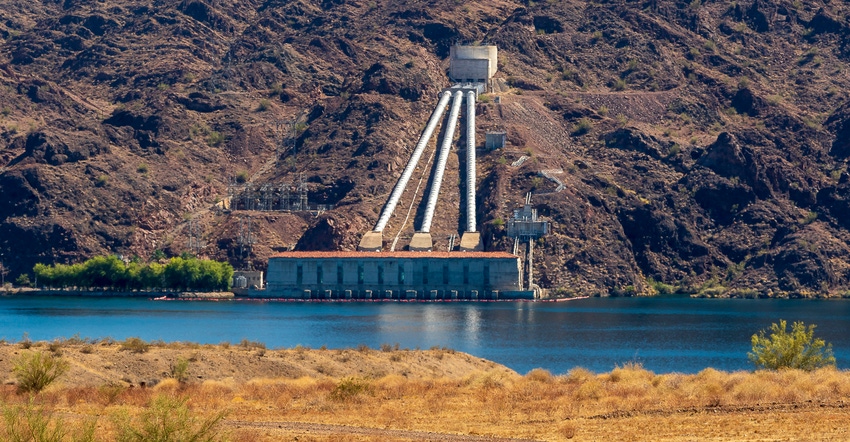
Concerns over crashing water levels in two of the West's larger reservoirs is raising a spirit of cooperation between the Colorado River states.
The head of Arizona's Department of Water Resources said recently that cooperation among the states – namely California, Nevada, and Arizona – is focused on slowing or reversing the drying of lakes Mead and Powell.
Tom Buschatzke, director of the Arizona Department of Water Resources, says there are real fears exist that lakes Powell and Mead could fall to “dead pool” status, the level at which water can no longer be released to the Colorado River.
Current conditions are not that dire, but Buschatzke told a room full of water attorneys in Scottsdale, Ariz. recently that all the best efforts of water managers in the past year were unable to stave off a Tier 1 restriction level at Lake Mead.
In water management jargon, California had a significant amount of "intentionally created surplus" (ICS), stored in Lake Mead that it was set to take after California cut its promised allocation of State Water Project (SWP) deliveries to 5%.
"They were going to pull it all out of the lake," he said
That would have driven Lake Mead even lower as officials were trying to prevent the shortage trigger that was hit earlier this year when the reservoir fell below 1,075 feet in elevation. Now at under 1,070, Lake Mead will be managed in 2022 under a Tier 1 shortfall, necessitating over 500,000-acre feet of water delivery cuts to Nevada and Arizona. California is not required to reduce its take on the Colorado River under Tier 1.
"California told us they want to work with us," he said. "Everyone's at risk because of the direction of Mead."
Growing drought concerns
Buschatzke said California was forced into pumping from the Colorado River this year after California effectively eliminated SWP deliveries earlier this year due to drought conditions across the state. The move forced southern California into relying upon its Colorado River allocation for most of its drinking water.
Water levels in the two large Colorado River reservoirs – Mead and Powell – are falling so fast that officials now worry both reservoirs could reach "dead pool," a phrase rarely uttered publicly by water officials. He did not mince words when he suggested water officials seem helpless to prevent this.
“Dead pool at elevation 895 could be a real possibility (at Lake Mead), and likewise in Lake Powell, he told the gathering of water attorneys.
Above dead pool sits minimum power pool levels in both lakes, the elevation at which water can no longer move through powerhouse intakes to generate carbon-neutral electricity for the West. When that happens the Western power grid will need to find power elsewhere, and likely at a much higher cost, he said.
Demand exceeds supply
The 1922 Colorado River Compact, which apportioned water to the various states, assumed a surplus. It did not assume ever-expanding cities and uses that would exceed river supply.
With drought conditions firmly entrenched across the West, Butschatzke said snow water equivalent of just 89% in the river basin led to a scant 32% of total runoff at peak. Earlier this year the system saw just over 10-million-acre feet of runoff while demanding about 15-million-acre feet to maintain status quo.
For Lake Powell in the upper basin this means a real fear that lake levels there will no longer sustain power operations at Glen Canyon Dam once the lake falls to 3,490 feet, or another 70 feet in elevation.
Buschatzke says that number may be optimistic. Bureau of Reclamation officials who operate Glen Canyon Dam think that level may be closer to the lower elevation balancing tier of 3,525 feet because of design parameters in the hydroelectric plant and water physics. If that is the case, the recent 24-month study released by USBR officials suggests Glen Canyon Dam could cease hydroelectric operations early next year.
Efforts to prevent that are under way now as water from upper basin reservoirs is being moved to Lake Powell to boost surface elevation and maintain hydroelectric operations there.
Lake Mead elevations are not projected to fare well either. Current USBR projections have Lake Mead falling to a Tier 2 shortage level of 1,050 feet sometime next year. Once Lake Mead falls to 1,045 feet, California must begin cutting its total take on the river system by 200,000-acre feet annually.
Once Lake Mead falls below 1,025 feet, total cuts to Colorado River water users exceeds 1.3-million-acre feet.
Negotiations
Buschatzke said talks between the Colorado River Basin states, the federal government, and Indian tribes – there are 22 tribes in Arizona and 30 in the basin – are under way to negotiate the declining lake levels and available water that will leave Western water users.
As director of Arizona DWR, he is the state's principal negotiator on Colorado River issues. He chairs the Arizona Water Banking Authority and co-chairs the Drought Inter-Agency Coordinating Council. He also represents Arizona in Indian water rights negotiations.
About the Author(s)
You May Also Like






